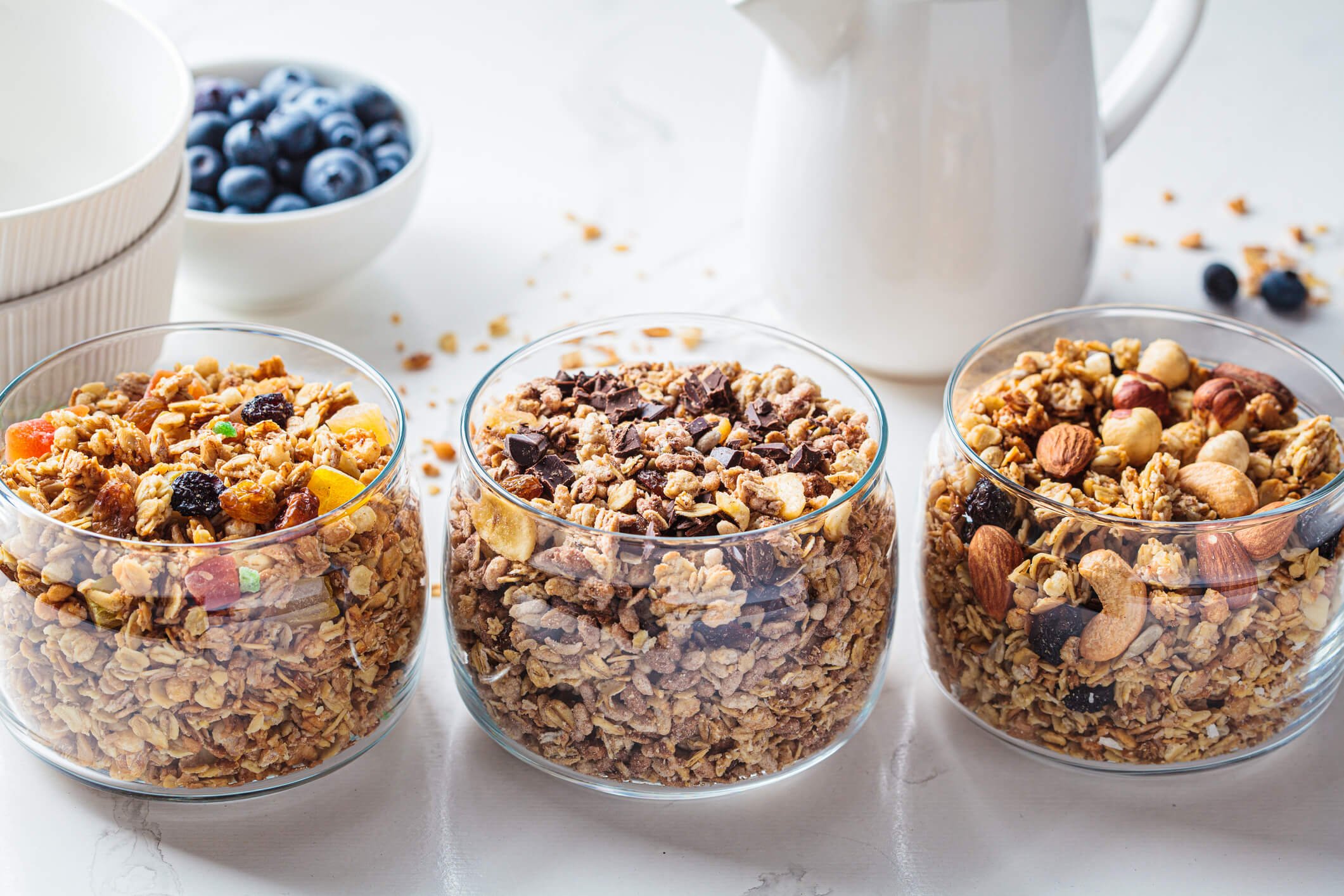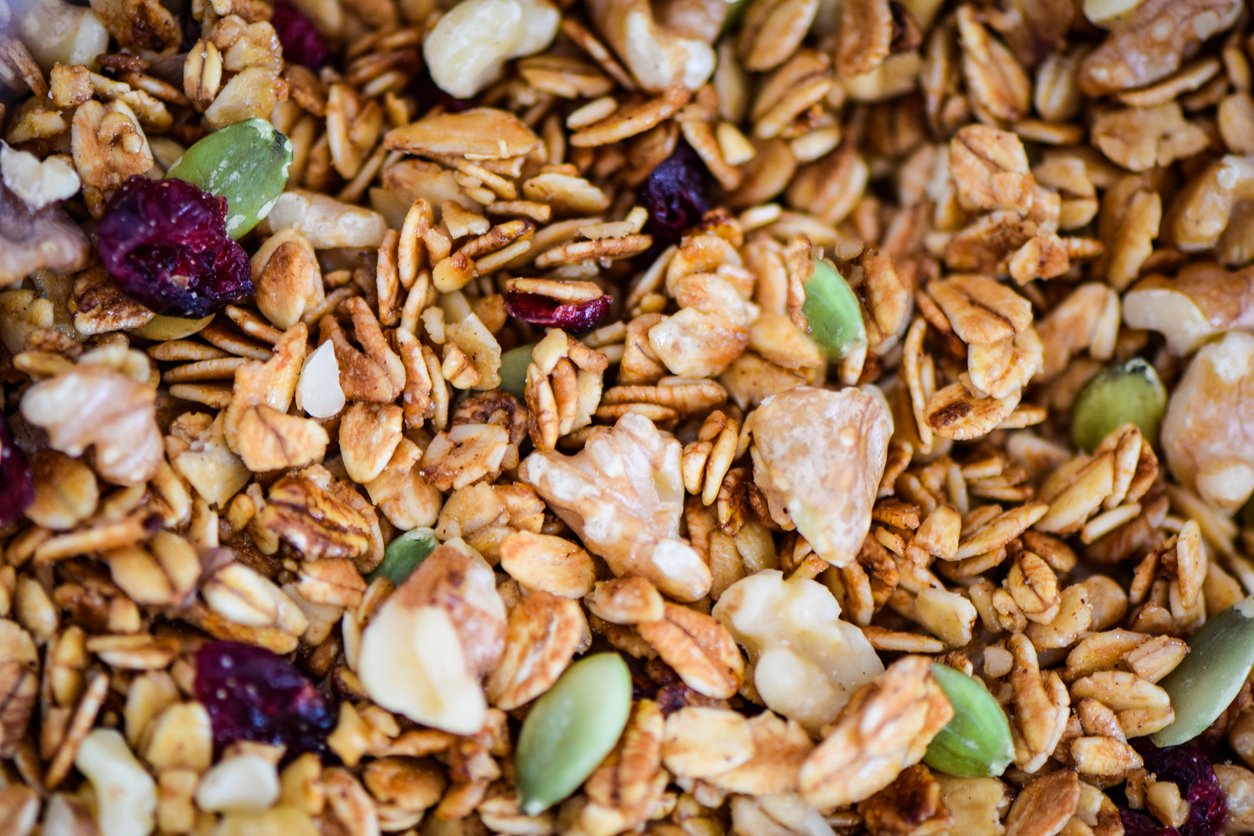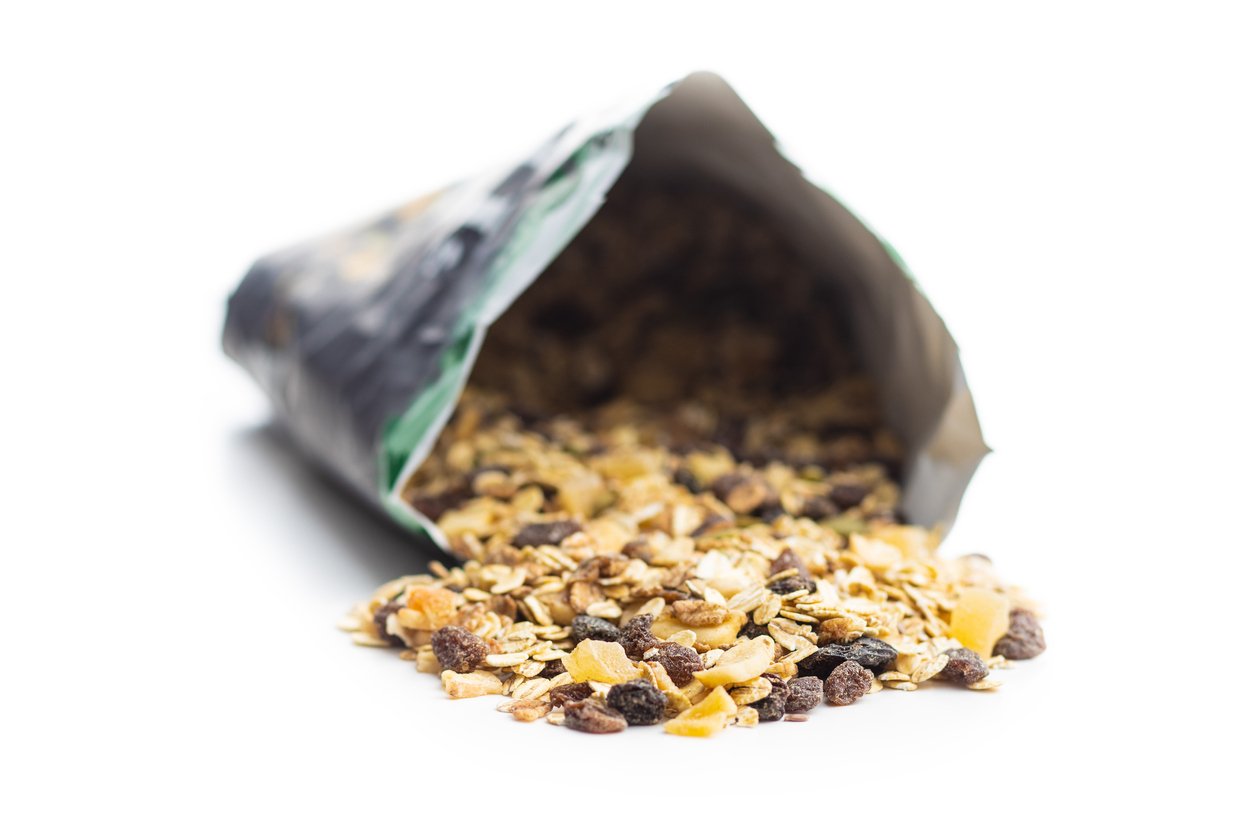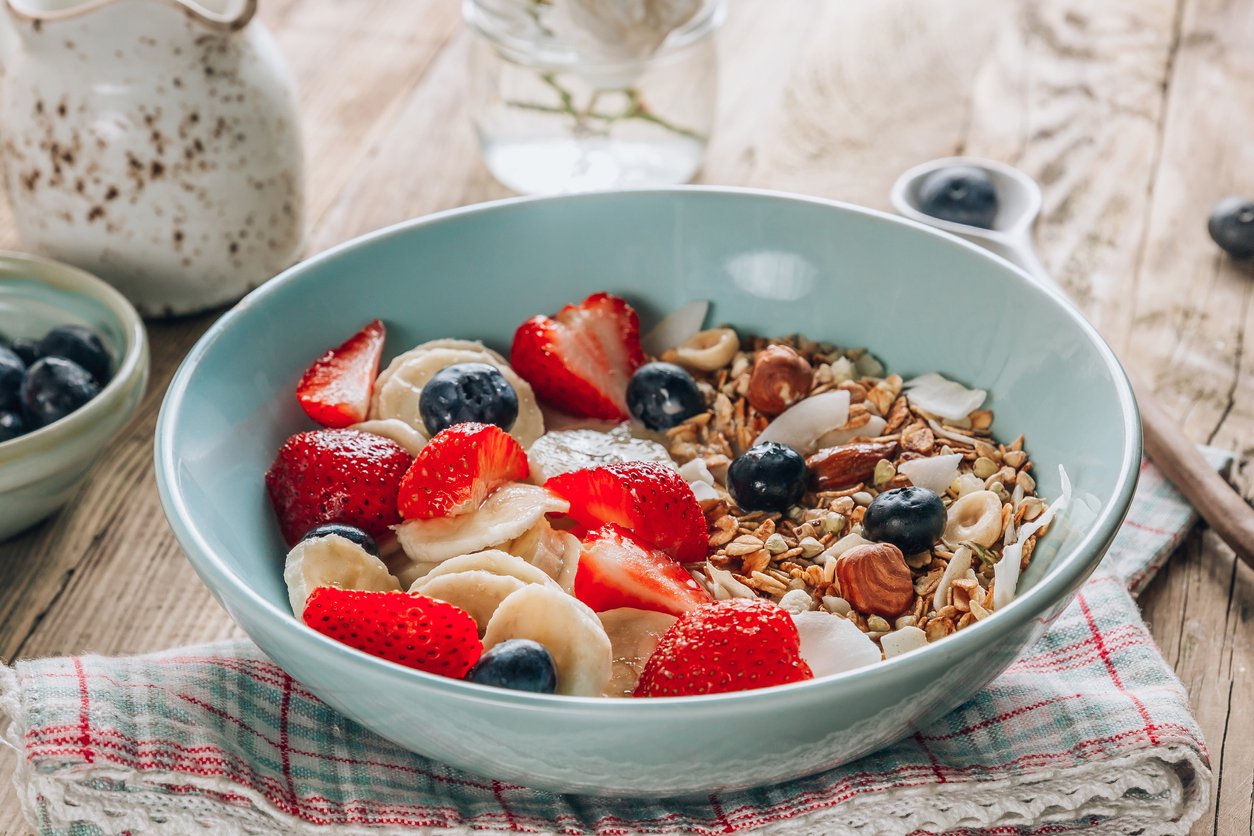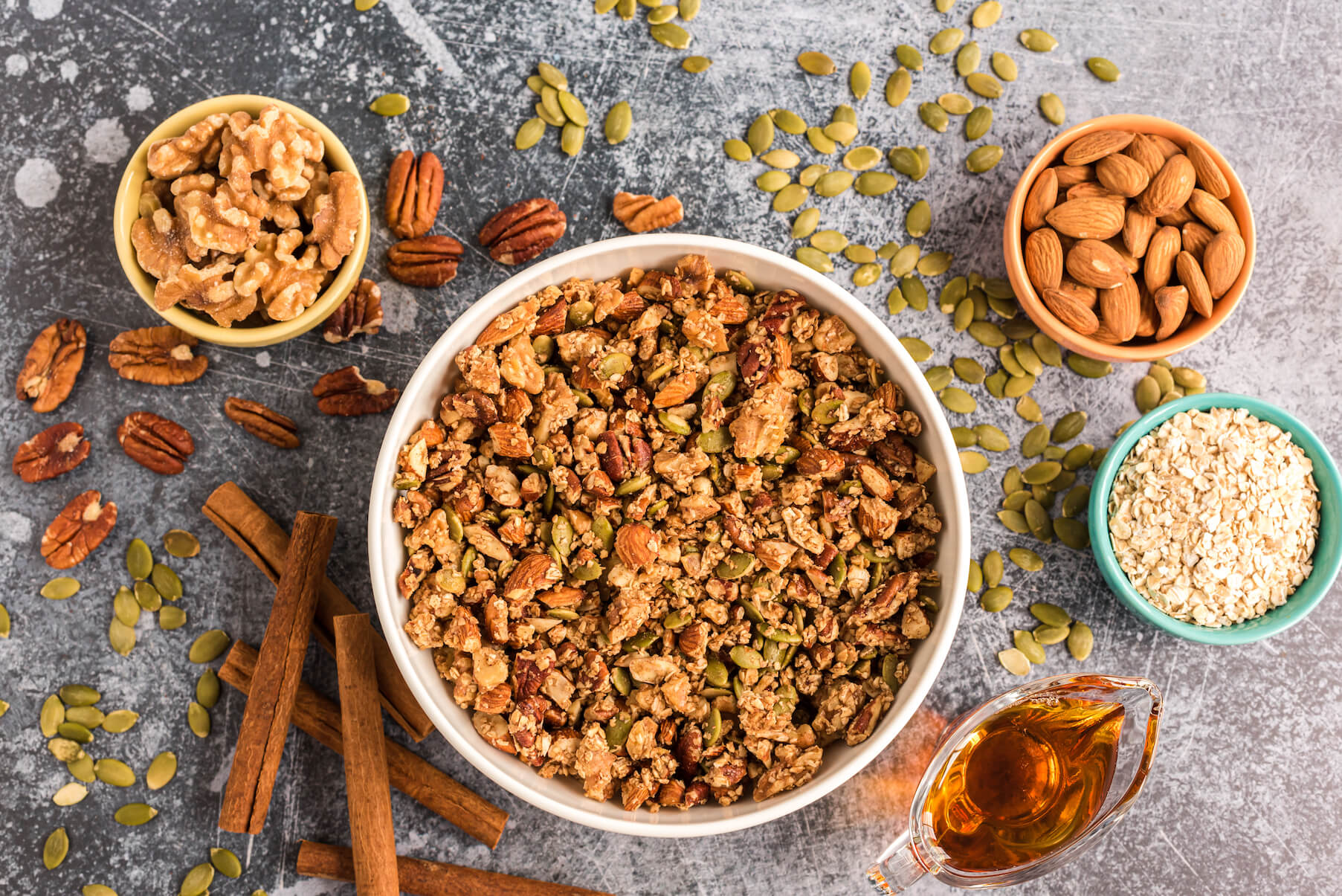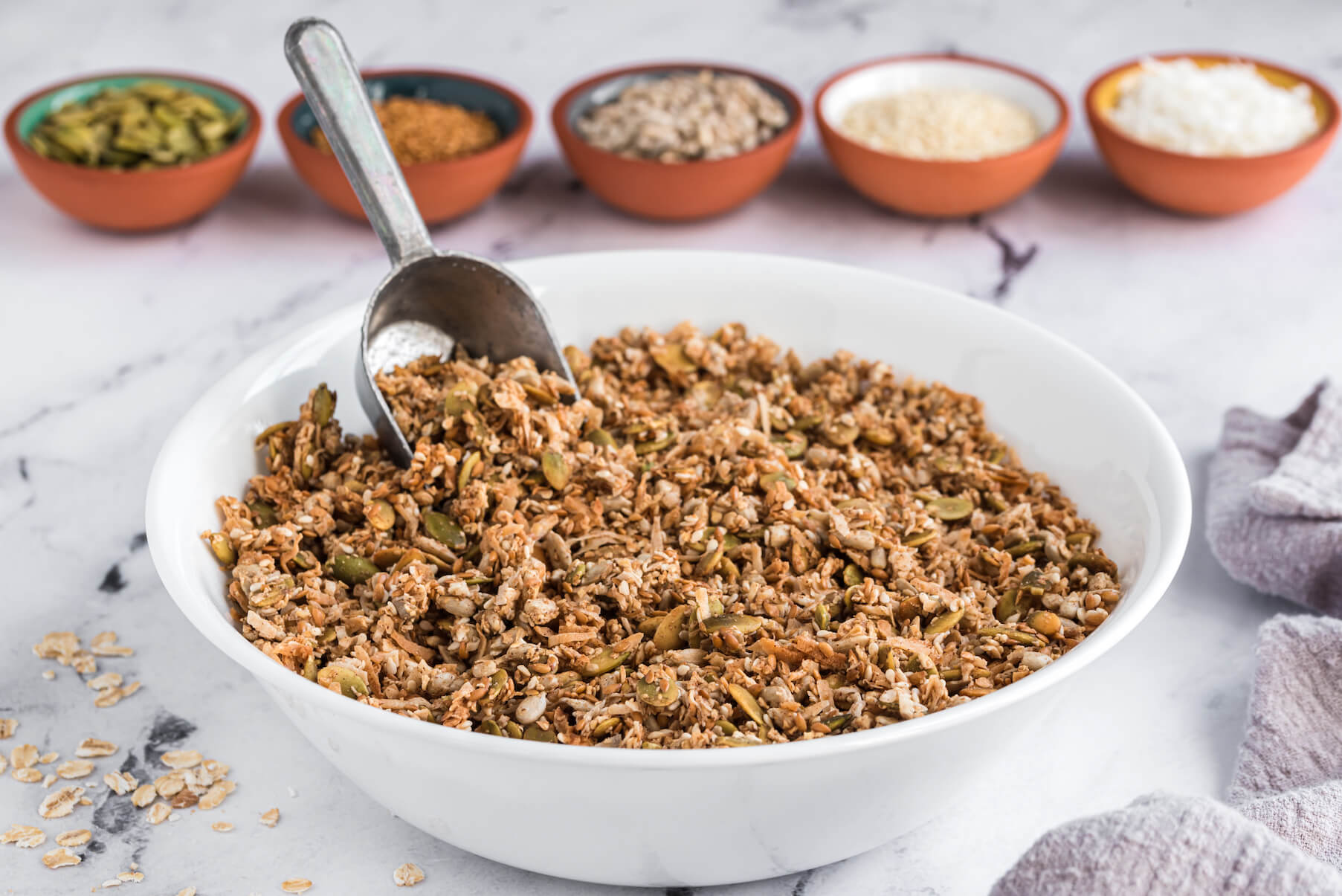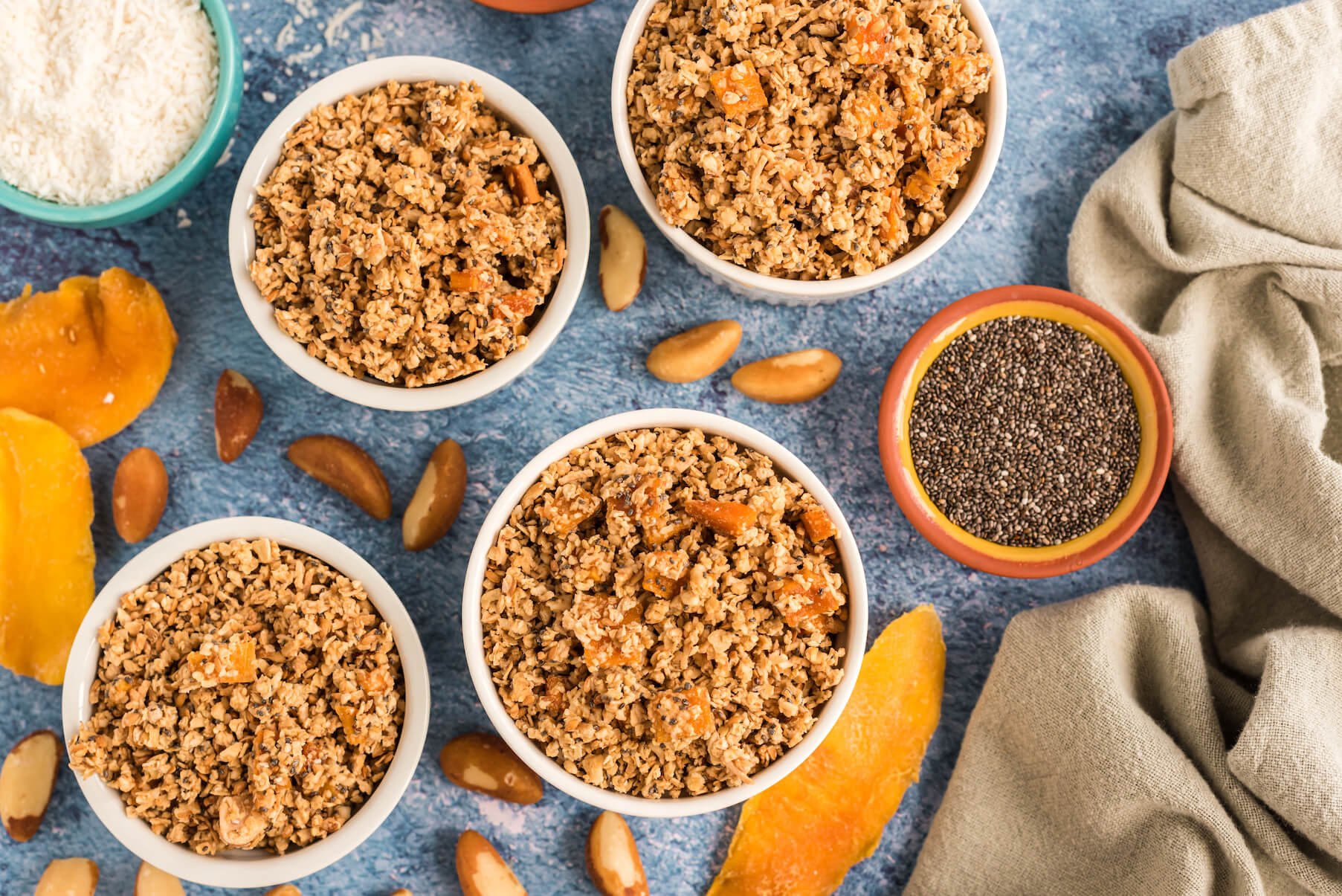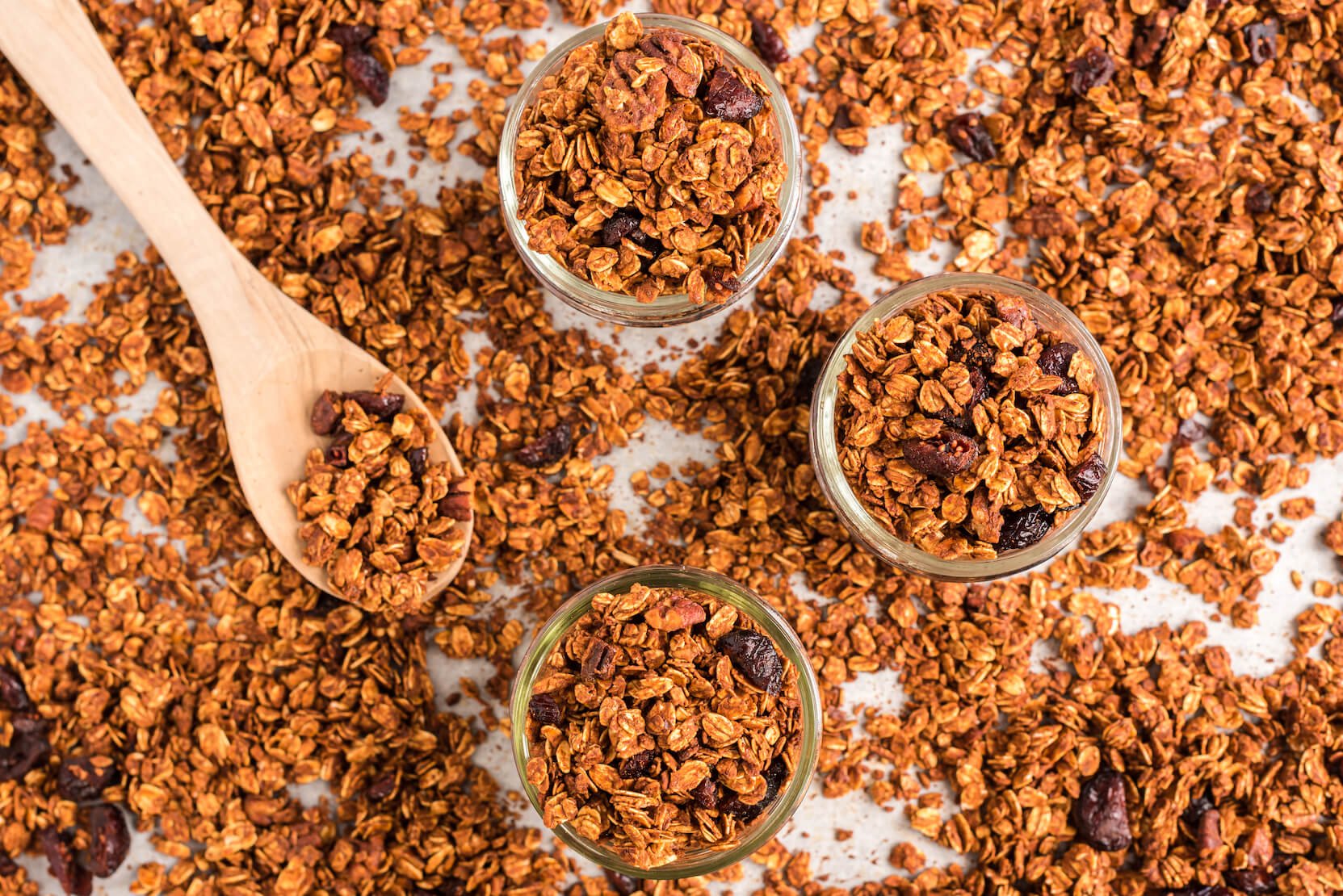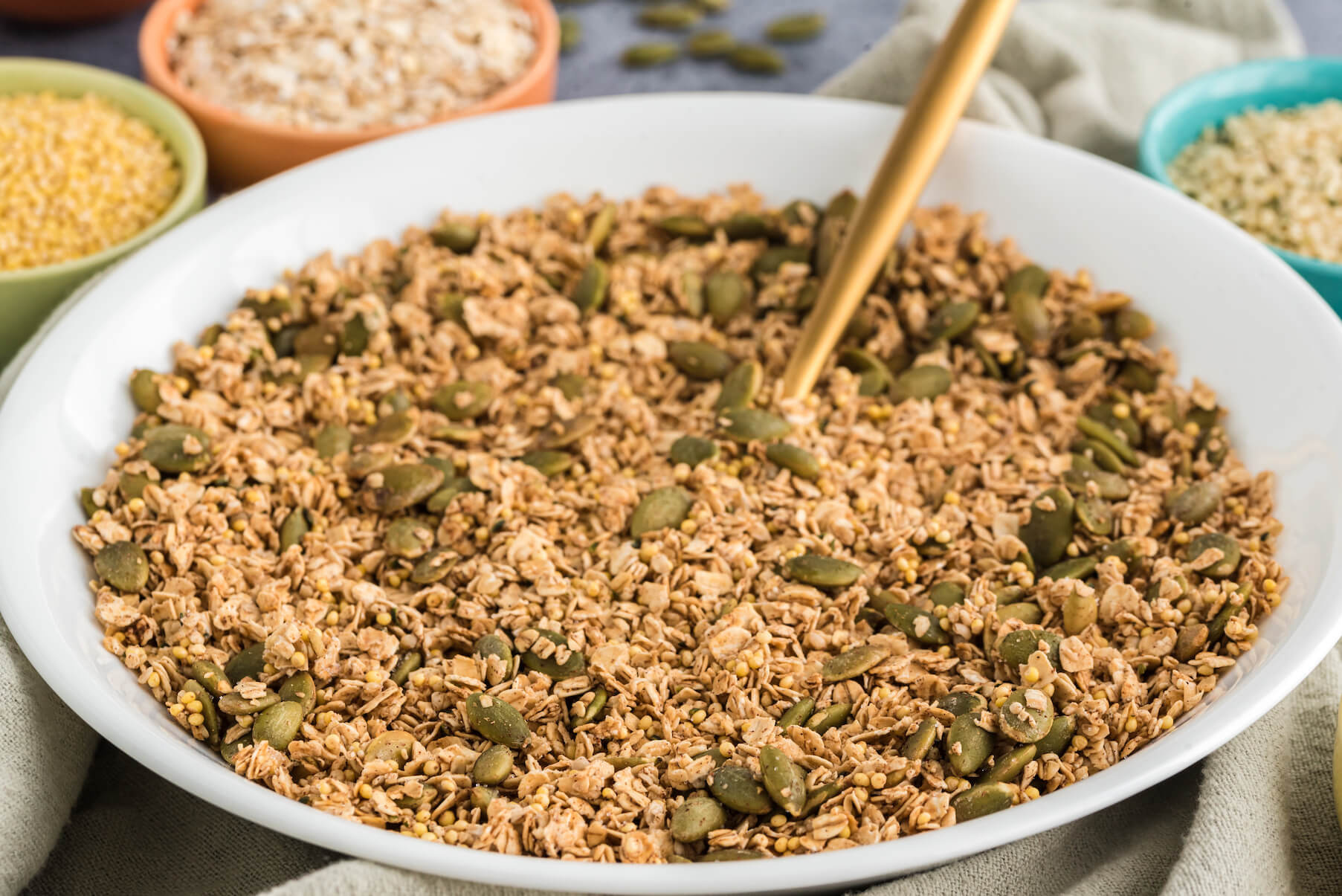One of the enduring legacies of the Woodstock music festival was to introduce granola to the hippie generation. Counterculture icon Wavy Gravy provided “breakfast in bed for 400,000,” divvying up pound after pound of bulgur wheat, rolled oats, currants, almonds, and dried apricots into paper Dixie cups to Woodstock attendees.
But the hippies didn’t invent granola. Its origins, ironically, were in a movement that couldn’t have been more different than the 1960s counterculture — the clean living crusade of the mid-19th century. Promoters of this way of life saw decadence and ruined health in the consumption of alcohol, rich food, and tobacco, as well as in the pursuit of sexual pleasure. Not exactly the hippie credo!
Two such clean living advocates ran their own healing retreats. Dr. James Caleb Jackson treated wealthy patients at his center in western New York state. As part of their restorative regimen, Dr. Jackson created a cold breakfast that he called “granula,” which was basically very large Grape Nuts made of twice-baked graham flour. Patients were to dip these wheat flour chunks into milk before eating.
Shortly thereafter, Dr. John Harvey Kellogg manufactured his own granula with oats and corn, and served it to the unwell elites who patronized his Battle Creek, Michigan sanatorium. Threatened with a lawsuit, Kellogg changed the name of his granula to granola and started selling it in bulk. This was the Kellogg family’s first foray into commercial breakfast cereal, initiating an empire that’s still going strong, and which has given us, for better or for worse, Froot Loops, Frosted Flakes, and Rice Krispies.
Fast forward roughly a century to the Woodstock generation, a cohort that rejected just about everything the clean living advocates believed — with one exception. Both groups distrusted the “artificial” and saw salvation in the “natural.” And granola, now morphed into a mixture of nuts, seeds, grains, and dried fruit baked with oil and sweeteners, was seen as a DIY alternative to the sugary breakfast cereals advertised on TV and taking up aisles of shelf space in mainstream supermarkets.
But what is granola, really? Is it, in fact, a health food? Are all granolas good for you? And how can you make your own granola recipes, even if you don’t need to feed half a million people?
What Is Granola?
Basically, granola is a cold, dry breakfast cereal that’s less processed than commercial cereal brands. Early versions of granola were combinations of processed and whole grains like oats and wheat, but the granola that’s associated with the 1960s includes nuts and seeds, and sometimes sweet extras like coconut shreds and dried fruit. By 1973, granola had earned a 10% market share among all breakfast cereals after capitalizing on its “back to nature” branding and positioning as a healthy breakfast option.
Modern granola has evolved to be more palatable than the hardtack-like fare served to 19th-century sanatorium guests. Now, granola is likely to include rolled oats or other whole grains, nuts and seeds, oil, a sweetener, and often some sweet goodie like dried fruit or chocolate chunks. And in some cases, even M&M’s.
Is Granola Good for You?
Because granola originated in a health movement and then reemerged during a “back to nature” movement, it benefits from a “halo effect” — many people assume that all granola is healthy. The real answer is that it depends on the ingredients included and how it is made.
Granola Brands to Watch Out For
Storebought granola, for example, is often a lot less healthy than you might assume. Its ingredients may include refined sugar or other added sugars. Some granola brands actually deliver more sugar to your bloodstream than popular breakfast cereals such as Cheerios. For example, Nature Valley Oats & Honey Protein Granola contains 16 grams of added sugar while the original Cheerios only contains 1 gram of added sugar per serving.
Commercially produced granola also typically contains refined oils, including GMO varieties of canola and other oils. Even if the oil used is non-GMO, its inclusion raises the caloric density of the granola. For example, Cascadian Farm Dark Chocolate Almond Granola has 260 calories per two-third cup serving, of which 72 calories (over 25%) come from fat (organic sunflower oil is fourth on the ingredient list, after oats, sugar, and rice).
Storebought granola is also often enhanced with “natural flavors,” which, in reality, may actually be far from natural.
Ironically, the original granola brand inspiration, Kellogg’s, also adds corn syrup, which contains GMO corn, and BHT — a food additive and known endocrine disruptor banned in the UK, EU, and Japan — to their granola.
Healthy Granola Brands
Fortunately, you may be able to find healthier premade granola brands. Purely Elizabeth (also available in bulk), Go Raw, and Lark Ellen Farm granolas are naturally sweetened and contain organic ingredients that don’t come from bioengineering or chemistry labs. However, if you follow a no-SOS diet (that eliminates added salt, oil, and sugar), or avoid all processed oils, these brands do contain coconut oil, so they probably aren’t for you.
Homemade Granola
If you want total control over the ingredients and quality of your granola, the good news is that it’s pretty easy to make it yourself. You can enjoy a wide variety of granola flavors and textures while sticking entirely to healthy, nutrient-dense whole foods like whole grains, nuts and seeds, fruit, and spices.
Whole grains are great granola ingredients that are known for helping with weight management and reducing the risk of heart disease. Nuts and seeds contain plant-based protein, vitamin E, and beneficial minerals like iron, calcium, and magnesium. Some nuts and seed, like walnuts, flax, and chia seeds, also provide important omega-3s that can be hard to come by in a modern plant-based diet. Worldwide, consumption of nuts and seeds is linked to lower rates of heart disease, type 2 diabetes, and cancer. And fruits are another good, homemade granola ingredient choice that’s high in antioxidants — essential nutrients that help the body prevent and fight off disease.
Oat-based granola, in particular, has been studied for its beneficial effects on gut bacteria and blood glucose. Researchers saw positive changes in these biomarkers after just three days of granola consumption.
How to Make Granola
You can make your own delicious and healthy granola with just a few key ingredients (and our delicious recipe, below). Once you get the hang of making granola, you can save money by buying your favorite ingredients in bulk (though you likely won’t ever compete with Woodstock for volume). One of our favorite online retailers for many of the bulk granola ingredients is Nuts.com.
Here’s what you’ll need to make your own granola:
- Rolled oats or another dried grain of your choice.
- Nuts and/or seeds (you can also include nut butters or ground seed meal, such as flax meal)
- A liquid to help make the granola crispy when baked (normally oil, but oil-free options include applesauce and aquafaba)
Optional granola ingredients include the following:
- A sweetener like maple syrup or date paste (can also serve as a binder to help wet ingredients stick to the dry ones)
- Small chunks or chips of fair trade or direct trade dark chocolate
- Dried fruit, or citrus zest
- Spices and flavorings (cinnamon, vanilla, salt, cardamom, nutmeg, etc.)
The basic preparation steps for granola are super simple:
- Preheat the oven to 350℉ (180℃).
- Combine all wet ingredients in a mixing bowl or measuring cup.
- Combine all dry ingredients in a separate bowl.
- Pour wet ingredients over dry ingredients and mix thoroughly until all the dry ingredients are coated.
- Bake the mixture in the oven until it turns golden brown.
- Let it cool, and then break it into chunks with a spatula or other kitchen tool.
Storing Granola
Store homemade or storebought granola in an airtight container. Because it’s sensitive to moisture, even the crunchiest granola can become soggy over time. Keep granola at room temperature, and use homemade granola sooner rather than later — ideally, within a month. Storebought granola is more shelf stable and may keep for up to six months unopened or around three months once opened. You can also keep it in the freezer (again, in an airtight container), where it will stay crunchy and yummy for up to three months. Of course, if you make good granola, you won’t have a problem using it up before the moisture starts to seep in.
What to Eat with Granola
Wondering how to eat granola? You can eat granola as a solo dish for breakfast or as a snack later in the day. (Or for breakfast later in the day — I don’t judge.) Soften it up with plant-based milk, for either a few minutes or, if you like very soft food, overnight. (My personal favorite, when it comes to plant-based milks, is Edensoy Unsweetened — which delivers 12 grams of organic plant protein from whole soybeans — in a single cup.)
You can also serve granola as a topping for yogurt, smoothie bowls, or nice creams. (That’s where a quarter cup makes sense as a serving!) And you can dip fruit like bananas or strawberries into melted dark chocolate, then roll them in granola for a crunchy topping.
Granola is also popular as a snack or breakfast bar. When making granola yourself, just cut the granola mixture into bar shapes after removing from the oven to make homemade granola bars. You can also make granola balls by shaping them into rounds before baking.
Finally, granola adds crunch and flavor to cobbler- or crisp-style warm desserts.
Granola Recipes
Homemade granola is so simple to make. Once you try it, you’ll likely ask yourself why you ever relied on the packaged stuff.
Consider our Simple Homemade Granola a blueprint for a delicious and healthy blend, ready to be customized to your liking. Super Seedy Granola offers a unique nut-free spin on the classic. Tropical Granola tastes like a hop, skip, and jump away to your favorite island getaway! Gingerbread Granola brings a touch of warmth and cheer any time of the year — get ready for its out-of-this-world aroma to fill your home! And Pumpkin Seed Millet Granola highlights the versatility of whole grains by bringing oats and millet together to create a fun textured and nutty flavored cereal.
Granola is wonderfully versatile, offering you a chance to personalize flavors, textures, and ingredients to suit your tastes. Each one of these delicious granola recipes is customizable, so have fun experimenting with ingredients that spark your creativity!
1. Simple Homemade Granola
The ingredients in this recipe happen to be some of our favorite nuts and seeds. We encourage you, however, to claim complete granola autonomy and creativity. Do you like a few extra pecans in your granola? What about almonds? Dislike walnuts altogether? Creating your own nut and seed blend that suits you best makes putting this granola recipe together fun — and results in a cereal you can feel proud (and excited) to eat!
2. Super Seedy Granola
Super Seedy Granola is made with — you guessed it — seeds! This nut-free granola is tasty by itself as a snack, or you can enjoy it as a cereal with plant-based milk or on top of plant-based yogurt for some crunch. Oh! it’s also packed with zinc, magnesium, and iron, making this snack one you’ll want to keep in your granola recipe library.
3. Tropical Granola
In this ode to tropical islands, granola ingredients, including sweet mango, shredded coconut, chia seeds, and Brazil nuts, combine deliciously to create an on-the-go breakfast or snack anywhere in the world! What’s great about this granola is that, in addition to fiber, protein, and healthy fats, you’ll get a daily dose of selenium from the Brazil nuts.
4. Gingerbread Granola
Perhaps the best thing about granola (other than its health benefits when it’s homemade) is that the flavor combinations are infinite. What makes this granola unique is the addition of molasses as sweetener and binder — and it’s the source of its signature gingerbread taste. It also helps to boost the nutritional value of the granola thanks to molasses’ antioxidants, iron, calcium, magnesium, potassium, phosphorus, and vitamin B6. Festive and nourishing — how sweet!
5. Pumpkin Seed Millet Granola
Are you a pumpkin spice fan? Then we’ve got you covered! This is a perfectly seasoned and satisfyingly sweet and crunchy granola packed with zinc, magnesium, fiber, B vitamins, and protein! Loaded with oats, pumpkin seeds, hemp seeds, and a touch of pumpkin pie spice, you’ll love having this granola on hand for healthy, plant-based breakfasts and snacking.
The Best Granola Cereal Is Homemade!
Granola can be a beneficial part of a healthy diet, for breakfast or any time of day. Whether or not granola is healthy depends on its ingredients. If you start with whole grains (especially a proven health-booster like oats) and include other nutrient-dense, whole plant foods, you can make delicious and healthy granola that’s also much less expensive than storebought.
There are lots of ways to make granola, as well as many other applications aside from a bowl for breakfast. Get creative, and you’ll be able to make and enjoy a variety of granola mixtures that suit your tastes and nutritional needs.
And you’ll have a ready solution if 400,000 people ever drop in unexpectedly!
Tell us in the comments:
- Do you have a favorite flavor of granola?
- What’s your favorite granola ingredient?
- What ideas have you gotten from this article for your next homemade granola?
Feature Image: iStock.com/Vaaseenaa
